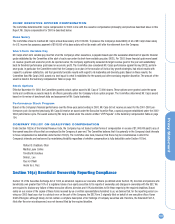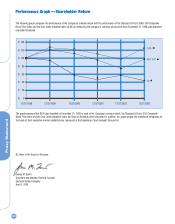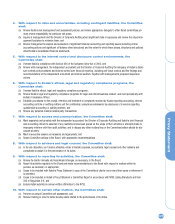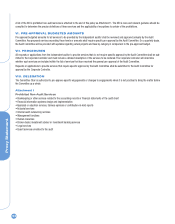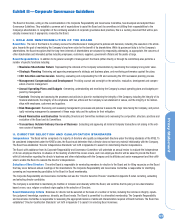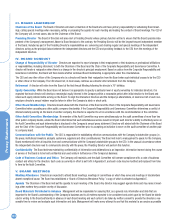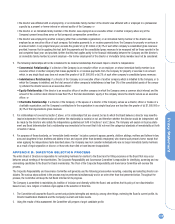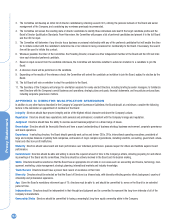Kodak 2003 Annual Report Download - page 129
Download and view the complete annual report
Please find page 129 of the 2003 Kodak annual report below. You can navigate through the pages in the report by either clicking on the pages listed below, or by using the keyword search tool below to find specific information within the annual report.
Proxy Statement
129
Exhibit III—Corporate Governance Guidelines
The Board of Directors, acting on the recommendation of its Corporate Responsibility and Governance Committee, has developed and adopted these
Governance Guidelines. They establish a common set of expectations to assist the Board and its committees in fulfilling their responsibilities to the
Company’s shareholders. In recognition of the continuing evolution of corporate governance best practices, this is a working document that will be peri-
odically reviewed and, if appropriate, revised by the Board.
I. ROLE AND RESPONSIBILITIES OF THE BOARD
Board Role
The role of the Board is to actively oversee the effectiveness of management’s policies and decisions, including the execution of its strate-
gies, towards the goal of maximizing the Company’s long-term value for the benefit of its shareholders. While its paramount duty is to the Company’s
shareholders, the Board recognizes that the long-term interests of shareholders are advanced by responsibly addressing, as appropriate, the concerns of
other stakeholders and interested parties including employees, customers, suppliers, government officials and the public at large.
Board Responsibilities
In addition to its general oversight of management, the Board (either directly or through its committees) also performs a
number of specific functions including:
• Maximize Shareholder Return
Representing the interests of the Company’s shareholders by maximizing the Company’s long-term value.
• Strategic Planning
Reviewing and approving management’s strategic and business plans, and monitoring performance against the plans.
• CEO Selection and Succession
Selecting, evaluating and compensating the CEO and overseeing the CEO succession planning process.
• Management Compensation and Development
Providing counsel and oversight on the selection, evaluation, development and compen-
sation of senior management.
• Annual Operating Plans and Budgets
Overseeing, understanding and monitoring the Company’s annual operating plans and budgets pre-
pared by management.
• Controls
Reviewing and assessing the processes and policies in place for maintaining the integrity of the Company, including the integrity of its
financial statements, the integrity of its compliance with law, ethics and the Company’s own statement of values, and the integrity of its relation-
ships with employees, customers and suppliers.
• Risk Management
Reviewing and assessing management’s processes and policies to assess the major risks facing the Company, and period-
ically reviewing management’s assessment of these major risks and the options for their mitigation.
• Board Nomination and Evaluation
Nominating Directors and Committee members and overseeing the composition, structure, practices and
evaluation of the Board and its Committees.
• Transactions Outside Ordinary Course of Business
Evaluating and approving all material Company transactions not arising in the ordi-
nary course of business.
II. DIRECTOR SELECTION AND QUALIFICATION STANDARDS
Independence
The Board will be comprised of a majority of directors who qualify as independent directors under the listing standards of the NYSE. To
be considered independent under the NYSE’s rules, the Board must determine that a director does not have any material relationship with the Company.
The Board has established “Director Independence Standards” set forth in Appendix A to assist it in determining director independence.
The Board, with assistance from its Corporate Responsibility and Governance Committee, will undertake an annual review to evaluate the independence
of its non-employee directors. In advance of the meeting at which this review occurs, each non-employee director will be asked to provide the Board
with full information regarding the director’s business and other relationships with the Company and its affiliates and senior management and their affili-
ates to enable the Board to evaluate the director’s independence.
Selection of New Directors
The entire Board is responsible for nominating members for election to the Board and for filling vacancies on the Board
that may occur between annual meetings of the shareholders. The Corporate Responsibility and Governance Committee is responsible for identifying,
screening and recommending candidates to the Board for Board membership.
The Corporate Responsibility and Governance Committee will use the “Director Selection Process” described in Appendix B when recruiting, evaluating
and selecting director candidates.
The Company is committed to maintaining its tradition of inclusion and diversity within the Board, and confirms that its policy of non-discrimination
based on sex, race, religion or national origin applies in the selection of Directors.
Board Membership Criteria
Nominees for director will be selected on the basis of a number of factors, including the nominee’s integrity, reputa-
tion, judgment, knowledge, experience, diversity, and Board needs. The Board is committed to a diversified membership. The Corporate Responsibility
and Governance Committee is responsible for assessing the appropriate balance of skills and characteristics required of Board members. The Board has
established “Director Qualification Standards” set forth in Appendix C to assist it in selecting Board nominees.




